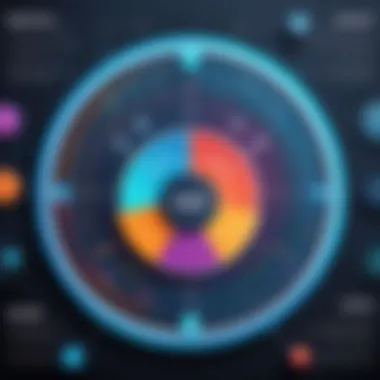Exploring Gamification Platforms for Enhanced Education


Intro
The integration of gamification in education represents a significant shift towards interactive learning strategies. As educators strive to engage students, gamification platforms have emerged as key tools in facilitating enriched educational experiences. These platforms incorporate game-like elements, such as points, badges, and leaderboards, motivating learners and encouraging active participation.
In this article, we will explore the landscape of gamification platforms specifically designed for educational settings. We will consider various functionalities they offer, their benefits for both learners and educators, and the challenges that may arise when implementing them. Additionally, we will discuss growing trends within this sector, present case studies, and provide insights based on user feedback.
This comprehensive guide aims to aid educators and decision-makers in choosing the right gamification tools. By fostering meaningful interactions through these platforms, we can foster effective learning environments that enhance knowledge retention and student motivation.
Prolusion to Gamification in Education
Gamification in education is a potent approach for enriching learning environments, making them more interactive and engaging. By integrating game design elements into educational practices, educators can enhance student motivation and retention of material. The importance of gamification is highlighted by its ability to leverage students' natural inclinations for competition, achievement, and cooperation.
Understanding the fundamental aspects of gamification is crucial for educators and decision-makers. It enables them to create a more dynamic and engaging learning experience. There are several key benefits of using gamification platforms in education, including increased student engagement, improved knowledge retention, and the creation of a more collaborative learning environment. However, considerations around implementation, such as institutional support and technical infrastructure, are equally important to address.
In this article, we will delve into the various facets of gamification platforms used in educational settings. Understanding the definition and essential components of gamification will provide the groundwork needed for exploring its historical context. Knowing how gamification has evolved can help in recognizing its potential to influence modern educational practices.
Definition and Fundamentals of Gamification
Gamification refers to the application of game principles and elements in non-game contexts, particularly education. It involves the use of points, badges, leaderboards, and challenges to motivate learners. These game-like mechanisms engage students in ways that traditional teaching methods may not achieve. The core elements of gamification include:
- Points: Awarding points for completing tasks encourages students to engage consistently.
- Badges: Recognizing achievements through visual rewards fosters a sense of accomplishment.
- Leaderboards: Comparing student performance can stimulate healthy competition.
- Challenges and Missions: Setting specific tasks adds an element of excitement and purpose.
By focusing on these gamification fundamentals, educators can tailor their teaching strategies to create a more engaging and interactive learning experience.
Historical Context and Evolution
The concept of gamification in education can be traced back to the early 2000s when educators began to explore innovative ways to motivate students. Its evolution reflects changing attitudes towards traditional pedagogy and a growing recognition of the need for engagement in the learning process. Initial implementations were often simplistic, focusing mainly on rewards and competition.
In recent years, advancements in technology have significantly affected the development of gamification platforms. The rise of digital tools and online learning environments has allowed for more complex and engaging systems to be established. Today, gamification not only motivates students through rewards but also promotes collaborative learning, critical thinking, and problem-solving skills.
"Gamification can transform educational approaches into stimulating environments that tap into students' intrinsic motivations."
As we progress through this article, we will explore various platforms that embody these principles and assess their effectiveness in diverse educational settings.
Understanding Gamification Platforms
Understanding gamification platforms is critical for educators and decision-makers who seek to enhance student engagement and learning outcomes effectively. These platforms provide tools that blend educational content with game-like elements, making learning more interactive and rewarding. By using gamification, educators can capture students' attention and motivate them to participate actively in their own learning processes.
The benefits of gamification platforms are numerous. First, they foster a dynamic learning environment where students feel empowered. When learners can track their progress, earn rewards, and engage in friendly competition, their motivation often increases. This can lead to improved learning outcomes, greater retention of information, and a deeper understanding of the subject matter.
In addition to enhancing engagement, these platforms also offer significant flexibility. Educators can tailor learning experiences to meet the diverse needs of their students. The adaptability of gamification allows instructors to choose from various game mechanics, such as points, badges, and leaderboards, that best fit their teaching objectives and the needs of their learners.
However, understanding the features and functionalities of gamification platforms is only the first step. Educators must also consider how to implement these tools effectively in their curricula. Successful integration requires not only the right platform but also a strategic approach that aligns with educational goals.


"Gamification can transform traditional classrooms into innovative learning spaces that encourage creativity and interaction."
A further critical aspect is recognizing the potential challenges. Not all gamification platforms suit every educational context. Technical limitations, institutional barriers, and varying student preferences could hinder the effectiveness of these tools. It is imperative for educators to thoroughly evaluate available platforms to find the one that aligns with their specific educational needs.
Overall, understanding gamification platforms is essential for realizing the full potential of gamification in education. By exploring available options, examining their core features, and comparing leading providers, educators can make informed decisions that enhance their teaching methods and ultimately benefit their students.
Impact of Gamification on Learning Outcomes
The integration of gamification in education holds significant potential to reshape traditional learning practices. Many educators are actively seeking innovative ways to boost student engagement, motivation, and ultimately, learning outcomes. Understanding the impact of gamification on these elements is essential for assessing its true worth in educational settings. When implemented effectively, gamification can transform the classroom experience into an interactive journey where learning is not just required but desired. The motivation derived from game elements plays a crucial role in this transformation.
Motivation and Student Engagement
Motivation stands at the forefront of educational success. Gamification targets this need by embedding game mechanics within the learning environment, facilitating a motivating atmosphere. Features such as points, badges, and leaderboards can make learning feel like an engaging game rather than a mundane task. For instance, a system like Classcraft allows students to earn rewards for their achievements, fueling greater participation and transforming their approach to learning.
Here are some key factors related to motivation:
- Goals and Rewards: Clear objectives give students direction. When combined with rewards, both intrinsic and extrinsic motivation flourishes.
- Feedback: Gamification provides immediate feedback, helping students understand their strengths and areas for improvement.
- Peer Interactions: Competitions and teamwork in a gamified classroom encourage collaboration and engagement among peers.
"Motivation can be a game-changer in the learning process, making even the toughest subjects enjoyable."
Enhancing Knowledge Retention
Enhanced knowledge retention is another critical outcome from the application of gamification. A playful learning environment not only captures attention but also aids memory through repetitive exposure and interactive experiences. Studies indicate that when learners actively engage with content via gamified techniques, retention rates significantly increase. Gamification achieves this by:
- Active Involvement: Instead of passively absorbing information, students interact with materials, which reinforces memory.
- Contextual Learning: The incorporation of real-world scenarios and storylines in games can help students relate content to practical situations, thus enhancing the learning experience.
- Repetition through Play: Games often require repeated practice of concepts, which embeds knowledge deeper in memory.
Ultimately, these aspects create a richer and more effective learning process, promoting a more profound comprehension of topics.
When considering the implementation of gamification in education, it becomes clear that its impact can be far-reaching, fostering an environment that enhances not just motivation but also the retention of knowledge.
Challenges in Implementing Gamification in Education
Implementing gamification in educational settings is not without its difficulties. These challenges can impede the goals of enhancing student engagement and improving learning outcomes. Understanding these obstacles is vital. It allows educators to strategize effectively, ensuring that the introduction of gamified elements truly enriches the learning experience.
Institutional Barriers
Institutional barriers often prove to be a significant hurdle in the adoption of gamification in education. Decision-makers may have concerns about the effectiveness and the cost of integrating gamified systems into existing curricula. Many institutions prioritize traditional teaching methods, which may clash with the innovative nature of gamified education. Furthermore, rigid administrative policies can slow down the implementation process.
Additionally, insufficient support from leadership can lead to resistance from teachers who are skeptical about the value of gamification. If training and resources are lacking, educators may feel ill-equipped to manage gamified platforms, which might discourage them from adopting these tools.
Technical Limitations
Technical limitations also pose real challenges. Not all institutions possess the necessary infrastructure to support gamified platforms. Slow internet connections or outdated hardware can significantly affect the user experience. Moreover, educators often rely on specific software that may not be compatible with gamified enhancements, causing frustration and reluctance to embrace new tools.


There is also the issue of technical support. If educators do not have access to timely troubleshooting help, the whole experience can become a chore rather than an engaging learning opportunity. Hence, relying on technology that is not universally accessible can limit the overall effectiveness of gamification in education.
Balancing Competition and Collaboration
Finding the right balance between competition and collaboration is another challenge that educators face. While gamification can promote healthy competition, it can also create an environment where students feel stressed or alienated. Some students thrive in competitive situations, while others may feel overwhelmed.
Educators must carefully design gamified experiences to keep students motivated without fostering a cutthroat atmosphere. Collaborative games can sometimes yield better learning outcomes than purely competitive ones, but integrating teamwork into gamification can be tricky. Hence, educators should explicitly outline expectations and encourage students to support one another.
"Effective gamification should foster an environment of collaboration, not just competition."
Case Studies of Successful Gamification Implementations
The exploration of gamification within educational settings is enriched significantly by examining successful case studies. These examples act as tangible evidence of how gamification platforms can create effective learning environments. They illustrate not only the potential benefits such as improved engagement and motivation but also provide valuable insights into the practical aspects of implementation and the challenges faced.
By analyzing real-world applications, educators can discern effective strategies that other institutions have utilized. This understanding is vital for making informed decisions about the adoption of gamification in their own curricula.
Primary Education Settings
In primary education, gamification has been particularly impactful. Schools utilizing platforms like Classcraft have reported enhanced student participation and engagement. In this setting, students create characters and embark on quests that correlate with their lessons. Each completed task earns them points and rewards, fostering a sense of achievement.
An example can be seen at St. Saviour's Unified School District. Teachers implemented a gamified reading program. Students earn badges for completing books and participate in friendly competitions to win prizes. The outcome was notable; not only did students show more enthusiasm in reading, but there was a measurable increase in comprehension skills as well. This instance exemplifies the positive influence that gamification can exert on fundamental learning activities.
Moreover, gamification can cater to diverse learning styles effectively. For instance, learners who may struggle with traditional educational methods often find motivation through interactive and visually rich experiences offered by gamified platforms.
Higher Education Contexts
Moving to higher education, gamification takes on a more complex form. A noteworthy instance can be found at Drexel University, which integrated gamification in its online courses. Students engage in simulations related to real-world applications of their subjects, earning points for participation in discussions and successful completion of projects. The results revealed an enhancement in overall student retention rates.
In addition, The University of Colorado Boulder adopted gamification strategies in their engineering program. Students participated in collaborative problem-solving activities, where they could earn levels or statuses based on group interactions and solution effectiveness. This approach not only improves motivation but also fosters teamwork—essential skills in professional settings.
"Gamification in higher education is not just about games but rather about fostering a culture of active participation and deep learning."
These case studies highlight the adaptability of gamification across different educational levels. They underscore the crucial need for educators to tailor gamification strategies based on their unique student demographics and learning objectives. With thoughtful implementation, gamification can indeed transform how education is perceived and delivered.
Future Trends in Gamification for Education
As the landscape of education continuously evolves, the integration of gamification is gaining momentum. Understanding the future trends in gamification is crucial for educators and organizations aiming to enhance learning through innovative methods. This section will discuss how emerging technologies and personalized learning experiences are reshaping gamification platforms, producing distinct benefits and considerations for implementation.
Integration with Emerging Technologies
The rise of emerging technologies like virtual reality (VR), augmented reality (AR), and artificial intelligence (AI) significantly influences gamification in education. These technologies bring immersive experiences to learners, transforming traditional teaching methods into engaging and interactive platforms.
- Virtual Reality and Augmented Reality: With VR and AR, educators can create immersive environments where students can interact with content in real-time. These technologies facilitate experiential learning, enhancing comprehension and retention. For example, a biology class can take a VR tour inside the human body, making complex systems easier to understand.
- Artificial Intelligence: AI can analyze learner behaviors and adapt experiences accordingly. This leads to more tailored challenges that align with each student’s abilities. The use of AI in gamification platforms can uncover insights that help instructors build their lesson plans based on data rather than intuition alone.
- Mobile Technology: Mobile devices are now ubiquitous, meaning learning can occur anywhere. Gamified learning applications provide flexibility, allowing students to complete tasks at their own pace and convenience. This portability fosters a culture of continuous learning outside traditional classroom settings.


Integrating these emerging technologies into gamification platforms is not without considerations. Data privacy becomes a primary concern; ensuring that student data is protected is paramount. Moreover, educators need appropriate training to effectively utilize these tools.
"Gamification in education is not just about competing, but about cultivating a deeper engagement with the material through technology."
Personalization in Learning Experiences
Personalized learning is becoming increasingly important as students have diverse needs and learning styles. Gamification platforms are now focusing on custom-tailored educational experiences that align with individual learner goals and preferences.
- Adaptive Learning Paths: These paths adjust to the learner's performance, offering customized challenges that promote mastery. This adaptability helps to maintain motivation and discourages frustration associated with static progressions.
- Learner-Controlled Avatars: Allowing students to create and tailor avatars enhances their connection to the learning environment. Customization adds an element of ownership, making learners more invested in their educational journey.
- Feedback Mechanisms: Instant feedback is essential for improving learning outcomes. Gamification platforms that incorporate meaningful feedback allow students to identify areas for improvement quickly, embrace learning curves, and adjust strategies as needed.
While personalization enhances the educational experience, it also raises critical questions regarding the design and implementation of these systems. Educators must assess whether a one-size-fits-all approach remains viable or if individualized strategies are necessary.
In sum, the future of gamification in education promises substantial advancements by incorporating emerging technologies and personalization. As these tools evolve, they will redefine the interaction between students and educators, making learning a more engaging and effective experience.
Ending
Summary of Findings
Through an analysis of gamification platforms, we find several key insights:
- Enhanced Engagement: Many platforms utilize elements such as points, badges, and leaderboards. These features significantly boost student participation and motivate learners to achieve their goals.
- Knowledge Retention: By incorporating game mechanics into the learning process, students often retain information more effectively. This creates a deeper understanding of the material and encourages lifelong learning.
- Flexibility in Implementation: Different platforms cater to various educational contexts, from primary education through to higher education. Institutions can select tools that best fit their unique needs and objectives.
Overall, the findings indicate a robust link between gamification practices and positive learning outcomes.
Recommendations for Educators
For educators considering gamification in their curriculum, the following recommendations are vital:
- Select the Right Platform: Understand the specific needs of students and align them with the functionalities of gamification platforms. Platforms should support the educational goals effectively.
- Foster Collaboration: Implement features that encourage teamwork and collaboration, balancing competition with collaborative tasks to create a comprehensive learning experience.
- Monitor and Adapt: Regularly assess student engagement and learning outcomes. Be flexible and ready to adjust strategies based on feedback to maximize the benefits of gamification.
- Professional Development: Invest in training for educators to ensure they understand how to integrate gamification into their teaching practices effectively. This investment can significantly enhance the overall success of gamification initiatives.
Integrating these recommendations can pave the way for more effective learning environments in the educational landscape, ultimately leading to greater student success.
Academic Resources
Academic resources represent a bedrock of any educational exploration of gamification platforms. They offer thorough research and empirical studies that validate the effectiveness of gamification in enhancing student engagement. Journals like the Journal of Educational Technology & Society and Computers & Education often contain peer-reviewed articles focusing on case studies, statistical analyses, and pedagogical theories around gamification.
Some important aspects of academic resources include:
- Rigorous Methodologies: Peer-reviewed studies ensure robust research methods that yield reliable data on the effects of gamification.
- Diverse Perspectives: Cross-disciplinary insights enrich the understanding of how gamification intersects with cognitive psychology and educational practices.
- Longitudinal Studies: Some resources provide long-term data on the impact of gamification, offering insights into both immediate and sustained effects on learning outcomes.
Utilizing academic resources empowers educators to ground their methods in research, leading to more effective teaching strategies and improved student outcomes.
Industry Reports
Industry reports provide a complementary perspective by examining current trends and practical applications of gamification platforms in real-world settings. Organizations like Gartner and research firms like Newzoo regularly publish reports that assess market dynamics, user satisfaction, and technological innovations. These insights enable educational stakeholders to grasp how gamification tools perform in various environments, thus informing their choices.
Key benefits of industry reports include:
- Market Analysis: Reports often include analysis on leading platforms such as Kahoot! and Classcraft, highlighting strengths, weaknesses, and unique functionalities.
- User Feedback: Many industry insights incorporate user testimonials, which can offer practical perspectives not always covered in academic literature.
- Technological Innovations: Industry publications detail how emerging technologies intersect with gamification, empowering educators to capitalize on current trends.
In summary, combining academic resources with industry reports creates a solid foundation for understanding and implementing gamification platforms in educational contexts. These references not only provide necessary credibility but also encourage ongoing dialogue and development within the field.













